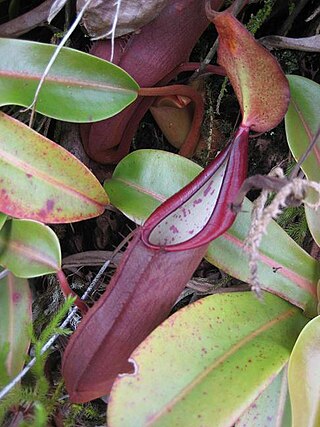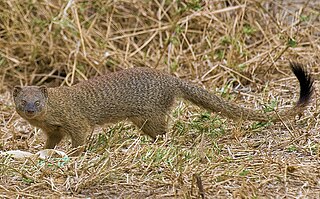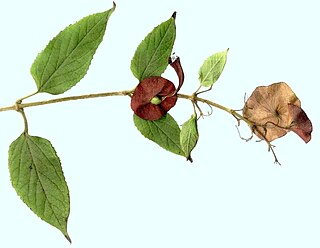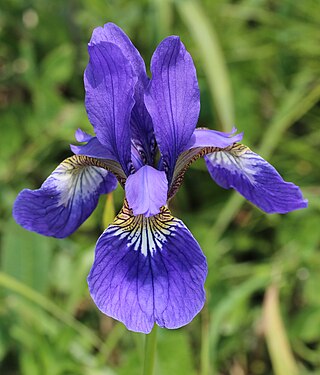
The modern pentathlon is an Olympic multisport that currently consists of fencing, freestyle swimming, equestrian show jumping, laser pistol shooting, and cross country running. Equestrian will be replaced by a form of obstacle course racing after the 2024 Summer Olympics.

Cornus sanguinea, the common dogwood or bloody dogwood, is a species of dogwood native to most of Europe and western Asia, from England and central Scotland east to the Caspian Sea. It is widely grown as an ornamental plant.

Nepenthes sanguinea is a large and vigorous Nepenthes pitcher plant species, native to Peninsular Malaysia and southernmost Thailand, where it grows at 300–1800 metres altitude. It is primarily a terrestrial species, but can grow as an epiphyte in the wet biome of upper montane forests. The pitchers are variable in size, from 10–30 cm tall, and range from green and yellow to orange and red. The insides of the pitchers are usually speckled with its two main colors. It was introduced to Victorian Britain around 1847 by Cornish plant hunter and botanist Thomas Lobb via the Veitch Nurseries.

Nepenthes junghuhnii is a tropical pitcher plant native to Sumatra. This species has been the source of much confusion since its discovery. The taxon originally named N. junghuhnii by John Muirhead Macfarlane has never been formally published. In 1994, taxonomist Jan Schlauer described N. junghuhnii as a "rather dubious species based on insufficient specimens". Nepenthes junghuhniisensu Macfarlane has not been relocated in the wild since the collection of the type specimen. It is characterised by strongly petiolate leaves and appears to be most closely related to N. bongso and N. spathulata; Schlauer considers it a possible synonym of the former.

The common slender mongoose, also known as the black-tipped mongoose or the black-tailed mongoose, is a very common mongoose species native to sub-Saharan Africa.

Holmskioldia is a genus of flowering plants in the mint family, Lamiaceae. It is native to the Himalayas but widely cultivated as an ornamental and naturalized in many places It contains only one known species, Holmskioldia sanguinea, commonly called the Chinese hat plant, cup-and-saucer-plant or mandarin's hat.

Laminella sanguinea is a species of small air-breathing land snails, terrestrial pulmonate gastropod mollusks in the family Amastridae. This species is endemic to the Hawaiian Islands. This species is ground-dwelling and often has debris on its shell to camouflage itself.

Formica sanguinea, or blood-red ant, is a species of facultative slave-maker ant in the genus Formica characterized by the ability to secrete formic acid. It ranges from Central and Northern Europe through Russia to Japan, China, the Korean Peninsula, Africa and also the United States. This species is coloured red and black with workers up to 7 mm long.

Sesapa is a genus of lichen moths in the family Erebidae. There are about eight described species in Sesapa, found in Taiwan, eastern China, and Southeast Asia.

Cycloneda sanguinea, also known as the spotless lady beetle, is a widespread species of ladybird beetle in the Americas.

Broughtonia sanguinea, also known as blood red broughtonia is a plant in the genus Broughtonia, a member of the family Orchidaceae. It was named in 1813 by its first describer, Robert Brown, for 18th century English botanist Arthur Broughton.

Euglena sanguinea is a species of the genus Euglena. The red colour is due to the presence of astaxanthin and the cells can be populous enough to colour water red. The pigment is used to protect the chloroplasts from light that is too intense, but as the light levels change the cells can take on a green colour as the red pigment is moved to the centre of the cells. Euglena sanguinea is known to make the potent icthyotoxin euglenophycin. Icthyotoxin euglenophycin is a toxin that is very similar in structure to solensopsin, a alkaloid that is found in fire ant venom. This is the only known species of euglenids that is able to form toxic blooms that cause tangible losses to fish farms.
Sesapa inscripta is a species of moth in the family Erebidae. It is found in eastern China.

Iris sanguinea is a rhizomatous flowering plant in the genus Iris and in the series Sibiricae. It is cultivated as an ornamental plant in temperate regions. It is one of the species considered a Japanese iris. It is from Asia, found between Russia, Mongolia, China, Japan and Korea. It has grey green leaves, an unbranched flowering stem and flowers in reddish-purple shades, from blue to blue-purple, red-violet, with a rare white variant.

Australoplana sanguinea also known as the Australian flatworm is a species of flatworm native to Australia. It has been locally introduced to New Zealand and is considered an invasive alien pest species in the UK. Two subspecies are currently recognized, A. s. alba and A. s. sanguinea Moseley, 1877.
Ultimate Fighting Championship (UFC) rankings, which were introduced in February 2013, are generated by a voting panel made up of media members. These media members are asked to vote for whom they feel are the top fighters in the UFC by weight class and pound-for-pound. A fighter is only eligible to be voted on if they are of active status in the UFC. A fighter can appear in more than one weight division at a time. The champion and interim champion are considered to be in top positions of their respective divisions and therefore are not eligible for voting by weight class. However, the champions can be voted on for the pound-for-pound rankings.

Psorthaspis sanguinea is a species of spider wasp in the family Pompilidae.

Nepenthes malayensis, or the striped Malayan montane pitcher plant, is a large species of carnivorous tropical pitcher plant native and endemic to eastern mountains of Peninsular Malaysia. The peristomes on both upper and lower pitchers are profusely adorned by reddish bands, or stripes, making the species rather attractive. It grows close to mountain summits around 800–1000 m above sea level in partially shaded areas, though some individuals have been seen growing in open areas. The species was first observed in 2018 and initially thought to be conspecific with N. sanguinea. Nepenthes malayensis formal description was published in late 2020 in Kew Bulletin and it is one of the three Malayan species described in the same year.
Orobanche sanguinea is a species of herb in the family Orobanchaceae. Individuals can grow to 0.17 m.















